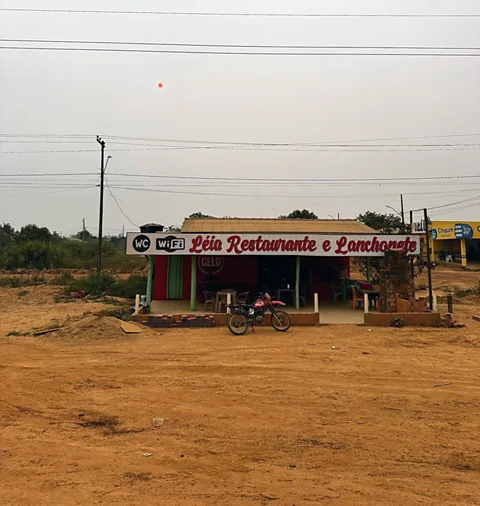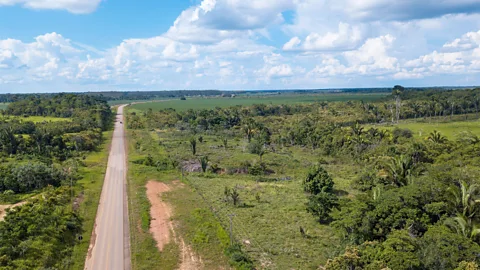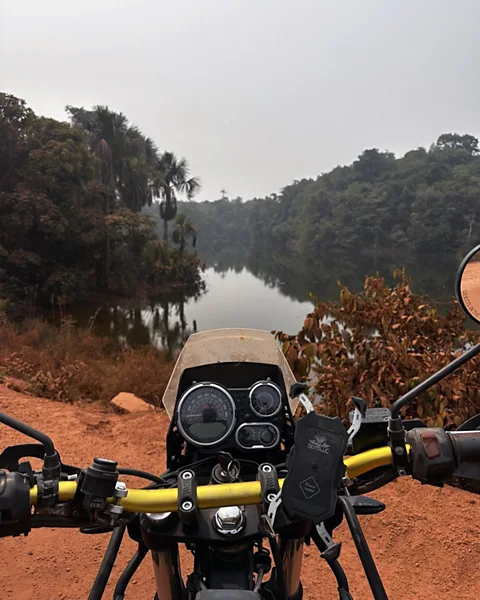The 900km Amazon highway that's dividing a nation
 Getty Images
Getty ImagesThe BR-319 is famed as one of South America's most challenging drives, but those who attempt it are rewarded with an unfiltered experience of the Amazon that few get to see.
Nobody seems to remember how Brazil's Road of Ghosts came by its name. Maybe it was due to the long, desolate stretches along its 900km course through the Amazon rainforest without a soul or settlement in sight. Or perhaps its "ghosts" are the burnt-out carcasses of overturned freight trucks found abandoned on the roadside. Though the highway's dire condition makes it impassable in the rainy season, drivers will often gamble on its condition in the summer months, braving crater-sized potholes and bouncing along dry, dusty ruts. Sometimes the odds aren't in their favour. I grip the handlebars of my motorcycle a little tighter and hope that they'll be in mine.
The Road of Ghosts – officially the BR-319 – is the only overland connection between the Amazonian city of Manaus, home to more than two million people, and the rest of Brazil, ending in Rondônia's state capital, Porto Velho. Built in the 1970s to facilitate the exploitation of the Amazon's natural resources, its construction led to an influx of pioneering migrants drawn to the region from across Brazil under promises of cheap agricultural land and opportunity. But without proper maintenance, much of the BR-319 soon fell into disrepair, leaving the Wild West-style communities that had emerged along its length isolated and forgotten.
Now, Brazil's President Luiz Inácio Lula da Silva has pledged to have the BR-319 rebuilt. The highway's advocates argue that this will help integrate the states of Amazonas and Rondônia into the national economy. But its detractors – including those in Lula's government – warn that restoring the BR-319 will transform it into an open gateway to previously untouched areas of the Amazon, paving the way – quite literally – for unprecedented levels of deforestation.
For travellers, the BR-319 carries a different significance. Famed as one of South America's most thrilling and challenging drives, it invites overlanding enthusiasts to test their mettle against a jungle environment that's equal parts extraordinary and exhausting. In the dry season, the Land Cruisers and adventure motorcycles that join the freight trucks on road are often manned by intrepid visitors detouring from the famed Pan-American highway (Porto Velho is less than 300km from the Bolivian border). A wild drive through the rainforest ends in Manaus, a vibrant and exciting city best known by travellers as the gateway to eco-adventures in the jungle and river expeditions along the Amazon.
 Dougie Loynes
Dougie LoynesFew people know more about driving the BR-319 than Flávio Bressan. Through his Brasília-based adventure company Cerrado Moto Aventura, Bressan leads motorcycle tours deep into the Amazon along the BR-310, guiding riders across the rainforest's difficult terrain while sharing the important story of a rich and diverse region at the crossroads of change.
These tours have also helped to map newly emerging roads and points of interest to inform future travellers. "Just a few years ago, we had almost no data on the Amazon's roads," Bressan tells me. "Only dramatised accounts from the travellers that had driven them. But the routes aren't as dangerous as many Brazilians believe," he adds, as he hands me the keys to the Royal Enfield Himalayan motorbike that will carry me into the heart of the Amazon. "It's still a challenging drive, but it's no longer true to call it the Road of Ghosts. You'll see that the Amazon is not as abandoned or underdeveloped as we're told."
My ride to Porto Velho takes me through the undulating plains of Brazil's vast interior, past endless soy plantations and remote agricultural towns. I'm travelling solo – Bressan is leading another tour along the Transamazônica, another rainforest highway that runs from Brazil's east coast to the state of Amazonas – but he's helped with my preparations and rented me one of his bikes. From Porto Velho, the first 300km north along the BR-319 makes for smooth riding, with some work having been completed on the road already. But this partially maintained section ends at the frontier town of Realidade, where the asphalt gives way to rough dirt and mud. The town's name means "reality" in Portuguese, and the harsh one here is that life might have been so different for its few thousand residents if the government had delivered on its promises to repair the highway running through the town.
I pull up to a weathered roadside cafe where patrons sit on a porch in plastic chairs and pour cold beer into tiny cups. Music drifting in from a tinny speaker is drowned out by the buzz of boisterous conversation. At the bar, a woman introduces herself as Léia, the owner. She tells me that she moved to Realidade with her family in 2019 when then-president Jair Bolsonaro pledged to have the BR-319 repaved. "But the road never happened," she says. "Five years later and we're still waiting for it."
 Dougie Loynes
Dougie LoynesA properly asphalted road would bring more opportunities to businesses like Léia's, who bought her diner on the BR-319 to cater to drivers on the long journey between Porto Velho and Manaus. "When it's dry, we see some traffic, and that's good for business," Léia says. "But when the rains arrive, there's nothing." The wet season creates additional challenges for the community, like sewage overflow and difficulties bringing in supplies. Léia's heard that the government plans to improve the road, but after so many false dawns she's reluctant to raise her hopes. "It would be nice, though," she sighs.
The next morning, a smoky haze hangs over Realidade. This is cattle ranch country, where farmers have always used fire to clear swathes of forest for pasture. But a historic drought has turned the Amazon into a tinderbox and the fires have got out of control. I take my phone out to record a man in a wide-brimmed hat scorching a tract of land by the roadside. His eyes meet mine and he says nothing.
Plan your trip
A 4x4 vehicle or adventure motorbike is recommended for tackling the BR-319. The dry season (June to September) is the safest time to go as the road becomes impassable during the rainy season. Cerrado Moto Aventura runs several group tours each year from Brasilia, along with bike rentals and logistical support for solo riders. Consider breaking the middle section up by staying overnight in the small town at the Igapo Açu Balsa (ferry).
As the day wears on, the equatorial sun slowly burns off the thick veil of smoke shrouding the rainforest. By midday, light is beaming through in shimmering waves, casting colour over the canopy and the jungle foliage. Giant ferns dusted with reddish-brown soil lifted from the trail guard the boundary between the BR-319 and endless untamed rainforest, their fronds rippling in a gentle breeze. I stop to take a photo of my bike on a rickety wooden bridge, and a cacophony of raucous squawking betrays two blue macaws streaming across the pale sky in the mid-distance.
And then, as suddenly as the rainforest crept up on me, it disappears. The jungle landscape's towering trees yield to sprawling farmland; from behind a low wooden fence, a herd of cattle eye me curiously. "Land here is cheap," Rosaline, the farmer's wife tells me. She and her husband moved here in January from Rondônia. They prefer not to use fire to tend to their pastures, but that hasn't stopped their land from burning. "The wind brings it to our borders. Now the fire has gone, but the smoke will stay until it rains."
 Alamy
AlamyEnvironmentalists worry that paving the BR-319 will provide land grabbers with easy access to unspoiled areas of the Amazon, allowing them to carve out spur roads for illegal logging and mining operations. They'll soon be followed by farmers who'll buy up the cheap land for cattle ranching and soybean plantations. It's been estimated that this would lead to a fivefold rise in deforestation, clearing the equivalent of an area larger than Florida.
Scientists call this the fish-bone effect: the BR-319 acts as the spine of the fish, and the inevitable and illegal adjacent roads represent its ribs. More deforestation and farming along the skeleton's ribs will likely mean more fires, which is bad news for everybody in the Brazilian Amazon and beyond. But it could also spell disaster for the rainforest's original custodians. More than 300 Indigenous groups in Brazil call the Amazon home, many of which could be directly threatened by a re-developed BR-319 if illegal land-grabbing and deforestation should follow.
Daiane Tenharim's village was built on land that's belonged to her people, the Indigenous Tenharim-Marmelos, for countless generations. Today, it's connected to the BR-319 via another jungle highway, the Transamazônica, which has brought a host of problems to Tenharim’s doorstep. Over a glass of fresh açai juice, Tenharim explains how the elders in her village have been suffering from respiratory problems linked to the wildfire smoke. But this is just the tip of the iceberg.
More like this:
• Pico da Neblina: A sacred peak off-limits for decades
• A 210km drive through 'the most beautiful place on Earth'
• Panemunė: The scenic road that saved Europe's banned language
"For years we've been fighting to evict the invaders on our territory," she says. "This is supposed to be protected land, but the government is slow to respond to our complaints."
Sometimes this can lead to conflict, with Indigenous communities like Tenharim's receiving threats from land-grabbers. "If the BR-319 is paved, more people will come from outside states. What protection will we have?" Tenharim asks. "We've always said we're not against the paving, so long as decisions aren't made without consulting the people who already live here. And that includes the Indigenous."
 Dougie Loynes
Dougie LoynesThe middle-section of the BR-319 is its most challenging: a 400km stretch of deep ruts and skidding sand spread over baked, bone-rattling earth. There are few ranches here; just dense jungle that threatens to swallow up what's left of the road. Every bump and jolt is a test of skill and endurance, but I catch myself grinning, immersed in the thrill of my expedition off the beaten track in the middle of the world's largest and most important rainforest. At a ferry crossing, I speak with a man in his 50s driving an expensive pick-up truck. Beside him sits his elderly father. They're heading to Manaus for their annual father-son fishing trip along the Amazon's tributaries. When I ask why they chose to drive to Manaus instead of fly, it's the father who replies. "Where is the adventure in that?"
The next day, after another morning spent bouncing along the BR-319's ruts and rocks, the sudden arrival of tarmac under my wheels feels like floating on a cloud. A smile escapes my lips as I twist the throttle and watch the speedometer climb. It's easy to imagine how a fully finished highway with a surface like this would be a lifeline to the communities who live along its length. But paving the way to progress could also threatens to cut deeper scars into an Amazon already under siege. One thing is for sure though: driving the BR-319 will always be a rip-roaring ride through the jungle.
--
If you liked this story, sign up for The Essential List newsletter – a handpicked selection of features, videos and can't-miss news, delivered to your inbox twice a week.
